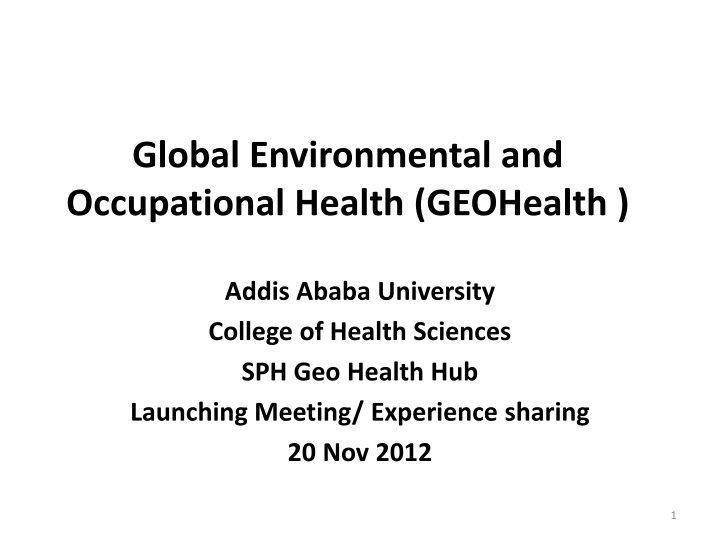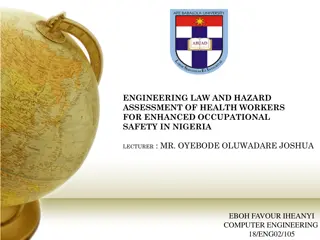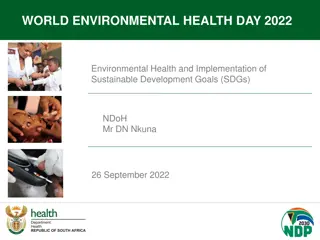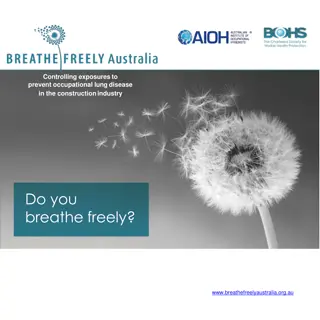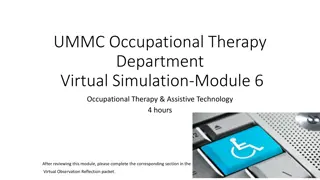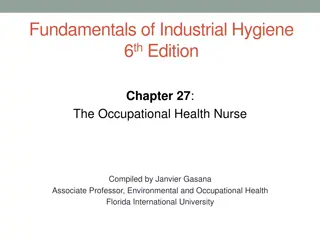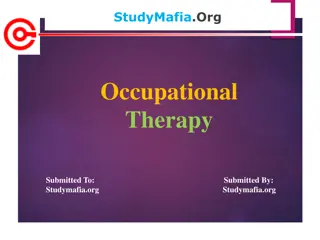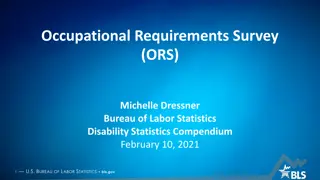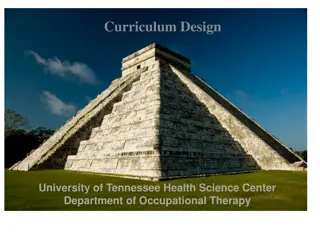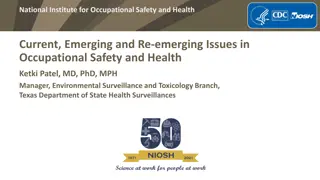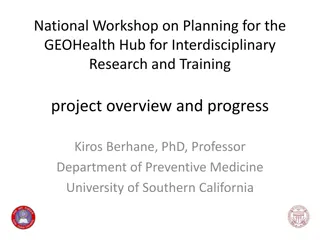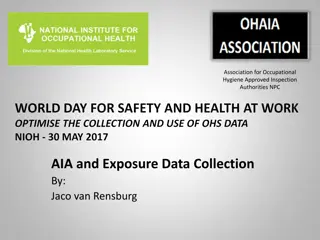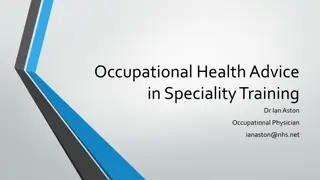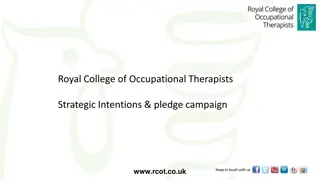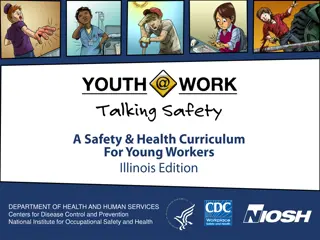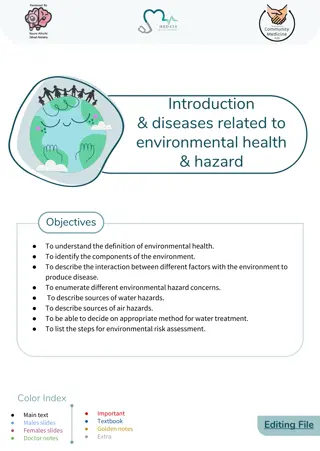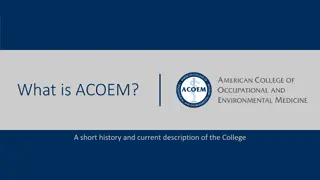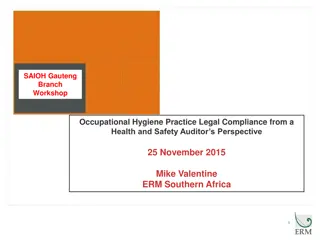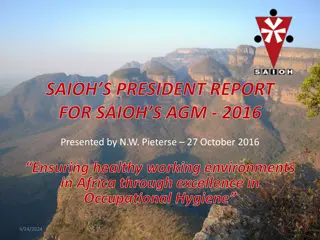Global Environmental and Occupational Health (GEOHealth )
"The launching meeting of the Global Environmental and Occupational Health (GEOHealth) Hub at Addis Ababa University College of Health Sciences School of Public Health (SPH) on November 20, 2021, involved experience sharing and discussions on key environmental and occupational health topics."
Download Presentation

Please find below an Image/Link to download the presentation.
The content on the website is provided AS IS for your information and personal use only. It may not be sold, licensed, or shared on other websites without obtaining consent from the author.If you encounter any issues during the download, it is possible that the publisher has removed the file from their server.
You are allowed to download the files provided on this website for personal or commercial use, subject to the condition that they are used lawfully. All files are the property of their respective owners.
The content on the website is provided AS IS for your information and personal use only. It may not be sold, licensed, or shared on other websites without obtaining consent from the author.
E N D
Presentation Transcript
Global Environmental and Occupational Health (GEOHealth ) Addis Ababa University College of Health Sciences SPH Geo Health Hub Launching Meeting/ Experience sharing 20 Nov 2012 1
Purpose of the meeting Experience sharing Encouraging staffs for application 2
The Topics NIH Opportunities What is GEOHealth/ Hub The NIH Grant process Reviewing Grant Application The way forward Challenges Lessons Learned Take home messages 3
National Institutes of Health Primary mission: To improve the health of the Nation How is that mission accomplished? By supporting and conducting research How do we support extramural Research? By issuing grants and contracts
Breakdown of FY 2011 Presidents Budget Request for NIH $32.2 Billion 9.6% 5.8% 2.6% 53.2% $16.4 B 11.0% 10.5% 4.7% 2.6% Research Project Grants (53.2%) Other Research (5.8%) R&D Contracts (11.0%) Research Mgmt & Support (4.7%) Research Centers (9.6%) Research Training (2.6%) Intramural Research (10.5%) All Other (2.6%) 5
Whats the Difference Between Grants and Contracts? GRANT CONTRACT Assistance Acquisition Government is Purchaser Government is Patron or Partner Purpose: to acquire goods or services Purpose: to support and stimulate research The direct benefit and use of the government Benefit a public purpose Investigator initiated Government initiated 6
GEOHealth Program Vision Develop/strengthen environmental/occupational health-related regional research collaborations Enhance infrastructure development Enhance research training, develop relevant curricula Mitigate the adverse consequences of environmental and occupational exposures, and Support the science needed in order to inform nationally- relevant policy development in LMIC 7
GEOHealth Hubs Multidisciplinary research group of investigators Serve as a focal point for all research, research capacity-building, training, and collaborative activities U.S. institutions and their partners may also be linked to the hub. A pair of institutions (one LMIC institution and one U.S. institution) would form a consortium in coordination with appropriate partners 8
Announced: Dec 2011 Funding Opportunity Announcement (FOA) Number RFA-TW-12-001 Funding Opportunity Title Limited Competition: Planning Grants for Hubs of Interdisciplinary Research and Training in Global Environmental and Occupational Health (GEOHealth) (P20) 9
The Funding Opportunity Announcement (17 Pages) In two sections: Overview and Full Text Purpose Funding Opportunity Information Award Information Eligibility Information Application and Submission Information Section V. Application Review Information Section VI. Award Administration Information Agency Contacts Time line with Key activities 10
Global Environmental and Occupational Health Eligibility One low- or middle-income country (LMIC) institution and one U.S for a bi-national paired consortium. Partnerships with appropriate LMIC governmental organizations and non- governmental organizations (NGOs) are encouraged (State Governments, Higher Education Institutions, Private and NGOs Each institutional partner can only submit one primary application. 11
Area of Geo Health Address and inform priority National and Regional environmental and occupational health policy issues through: Research Research training and Curriculum development activities In broader Environment: climate change, malaria, pollution (water, air),, , ,, Occupational health, work place safety: policy, ,,, Agricultural health 12
GeoHealth Hub: the collaborative research Considers several core science areas, including fields such as epidemiology, biostatistics, genetics, environmental science, industrial hygiene, systems science, toxicology, behavioral science and implementation science Our Team: Environmental health, occupational health, epidemiology, biostatistics, development, energy, malaria, Organizational mgmt, Global Health, ,,, (8 USC + 8 national) 13
Major Project components Phased into two levels 1st level: One Year (Sept 2012-Aug 2013) Situational analysis and needs assessment in the area of GeoHealth What are Gaps and needs: Research? Training? Policy? Capacity? Organization? 2nd level: Create a Regional GeoHealth Hub (Center of GeoHealth) Involving East African Countries 14
The Grant Process Overview Submitting Planning (LOI) USC + AAU Writing NIH Announc ement (Jan 2012) Receipt and Referral (1-3 M) Pre-award Notification of Award Congratulation Peer Review (4-8 Ms) Initial level Priority Scores Notifying the Grantee Award Post Award Management 15
The process of getting the Award S5teps Remark NIH Announcement Berhane Planning for application Writing the project Kiros) Jan Feb 2012 (intensively) Back and forth; Skype, Internets Submitting the project line) The project, Support letters Electronically: using User name, pass word 1 USC contact Person: prof Kiros 2 LOI, beginning of Feb/2012 Agreed to apply Aug 2011 (Prof 3 1st week of March 2012 (3rd dead 4 16
The Process contd 5 Receipt and referral Peer Review Grant Number: 1 R24 TW 009552 01 March- Sept (about 7 Months for both) Notified Sept 25/2012 Transferring Grant: Oct 26 2012 Implementation Plan Implementation Monitoring Activities Reporting Performance, account,,, 6 7 8 Award Post Award management 17
Support letters for the Planning Grant Multi-desciplinarity nature; Organizations: FMOH, FEPA, FMOLSA, NGOs: PANA Addis Ababa University: Horn of Africa, Inst of Environment and Development Professionals-Experts: 12 individuals (5 from USC and 7 from AAU (SPH+Horn of Africa+Inst of Env t and Development) 19
GEOHealth PIs AAU/ Ethiopia 1. Dr Abera Kumie 2. Dr Getnet Mitike 3. Worku Tefera 4. Dr Belay Semane 5. Dr Arara Asfaw 6. Dr Alemayehu Worku 7. Dr Wakgari Deressa 8. Tadesse Amera USC/ USA 1. Prof Kiros Berhane 2. Professor Jonathan Samet 3. Prof Frank Gilliland 4. Dr Heather Wipfli, 5. Dr Nuvjote (Nivvy) Hundal 6. Prof Rob McConnel 7. Prof Ed Avol 8. Prof Andrea Hricko 20
Support letter Background of the organization / individuals Willingness Appreciation of the problem of environment and Health Area of support/ expertise Signature and Seal 21
Peer Review System for Grants 1st level Scientific Review Group (SRG) Independent outside review Evaluate scientific merit, significance Recommend length and level of funding Output: Impact/Priority Score and Summary Statement Advisory Council Assess quality of SRG process Offers recommendation to Institute Staff Evaluates program priorities and relevance Advises on policy 3 - 7 months 2nd level Output: Funding Recommendations 1 - 3 months Institute Director Makes final decision based on Council input, programmatic priorities Must also Pass Administrative Review Output: Awards or Resubmission 22
Peer Review: Summary statement Examples: Multidesciplinarity (climatologist was suggested) Sustainability Innovative: Specific issues (sp obj, type of data, ,,) How translating research findings Evaluation points: in 3 Critiques on Strengths / Weaknesses Significance Investigator/s Innovation Approach Environment Impact/Priority Score 23
The NIH Peer Review Process New Score Descriptors Impact Score Descriptor 1 Exceptional 2 Outstanding 3 Excellent 4 Very Good 5 Good 6 Satisfactory 7 Fair 8 Marginal 9 Poor High Impact Moderate Impact Low Impact
The Grant USD$ 100, 000 Divided into two portions: USD$ 50,000 per year The transfer for the first year has started in dividing 3 lots (Oct 2012, Jan 2013, April 2013) 25
Challenges Unfamiliarity Lack of Experience The Experience of USC was immense The Experience of MEPI, Depart of Psychiatry was very helpful in all matters of the application process 26
The way forward Year II Developing documents on Research, training, capacity building,,,, Working with Countries in East Africa Dissemination workshop Competing for a Full GEOHealth with the Awards in 2014 Creating the Hub (Center/ Network) Year 1: Organizing the accounting system Completing the Implementation detail Plan of Action Developing tools of data collection Launching meeting Inception Workshop Data collection Writing a report (5-6 in a package) 27
Grants Awarded: USD$ 1.3 mln Bangladesh Chile China (3) Columbia (2) Peru Romania Suriname Ukraine Thailand Ethiopia Gambia Ghana Nicaragua Uganda 28
Lesson 1: Getting to the Top: Writing Great Grants Components of successful applications Strong Idea Strong Science Strong Team Diverse expertise Strong Presentation Match idea/science to the NIH Institute Every IC has specific mission Hone high-quality grant writing skills Communicate scientific content compellingly Follow all the instructions 30
Lesson 2: Writing a Grant Application Successful applications typically are: Well-focused and explicitly written Not overly ambitious Understandable by a na ve reader 31
Take Home Messages: if you want to apply Lots of directions and opportunities at the NIH Monitor Institute/Center Web sites and the NIH Guide for Grants and Contracts (http://grants.nih.gov/grants/guide/) Get to know the Program Partner/s for your scientific area Contact them about your research ideas - Fit with IC mission and priorities - Best grant activity code or program - Best study section for review Participate in review of grant applications (study sections) 32
Path to Success at NIH Do your homework; learn a bit about the grant process and the options. Office of Extramural Research: Basics - http://grants.nih.gov/grants/grant_basics.htm Overview - http://grants.nih.gov/grants/grants_process.htm IC priorities: http://www.nih.gov/icd/index.html NIH Guide Provides Weekly Updates on Funding Opportunities: http://grants.nih.gov/grants/guide/ Center for Scientific Review: http://cms.csr.nih.gov/PeerReviewMeetings/CSRIRGDescription/ http://www.csr.nih.gov/committees/rosterindex.asp Institutes and Centers: http://era.nih.gov/roster/index.cfm Areas of IC interest: http://www.nih.gov/icd/index.html 33
The NIH Peer Review Process Additional Information Enhancing Peer Review Initiative http://enhancing-peer-review.nih.gov/ Office of Extramural Research Peer Review Process http://grants.nih.gov/grants/peer_review_process.htm Peer Review Policies & Practices http://grants.nih.gov/grants/peer/peer.htm Center for Scientific Review http://cms.csr.nih.gov/AboutCSR/Welcome+to+CSR/
